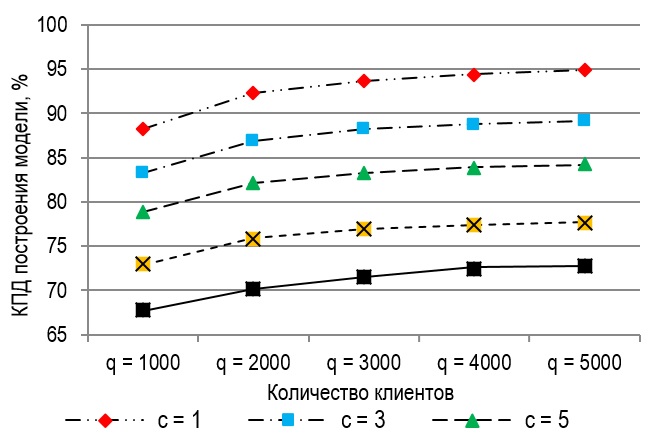
Decision Functions Model for Metric Methods of Pattern Recognition
https://doi.org/10.31854/1813-324X-2025-11-2-84-100
EDN: SIYZKF
Abstract
Currently, data mining based on machine learning plays a key role in decision support in various industries. An important practical problem of machine learning is the implementation of object classification in real time, which can be achieved by parallelizing data processing algorithms both for input data and for decision function data. To improve the efficiency of parallelizing machine learning methods, a unified decision function model has been developed. The Relevance of this research is to present a unified decision function model in the framework of machine learning algorithms and functions for its parallelization both in terms of input data and decision function data.
The essence of the presented approach is that the features of the operation of metric methods of machine learning are analyzed, independent data for processing are presented using different categories of the analyzed property, developed decision function model describes the object features for input data and decision function data using standardized elements and including functions for their parallel processing based on group parallelization of objects. The proposed approach is based on the use of methods for analyzing algorithms and computational complexity, mathematical statistics and the methodology of designing parallel algorithms.
Experiments have shown that parallelization of the proposed decision function model for the potential function method allows increasing the classification efficiency for one object using additional computing resources, and for a group of objects within the limits of the computer's memory size or planning horizon.
The novelty of the proposed approach is that the model differs from existing ones in a method of formalizing objects and their features using unified elements for training and classification objects and has a structure and functions oriented towards its parallel processing by pattern recognition methods based on decision functions within the framework of group parallelization of objects.
Theoretical significance: the model is unified and can be used to parallelize other pattern recognition methods that can be described by similar parameters, architecture, and classification features.
The practical significance of the proposed approach is that the model allows decomposing the pattern classification problem into separate subtasks of finding regularities between input data and decision function data.
About the Authors
I. V. AleksandrovRussian Federation
R. M. Vivchar
Russian Federation
R. V. Kirichek
Russian Federation
References
1. Balashova I., Tereshchenko T. Decision Support Systems. The Scientific Heritage. 2021;79-4(79):3‒7. (in Russ.) DOI:10.24412/9215-0365-2021-79-4-3-7. EDN:VBGSEN
2. Konev K.A. Machine Learning for Quality Decision Support in an Industrial Enterprise. Economics. Information technologies. 2023;50(3):689‒703. (in Russ.) DOI:10.52575/2687-0932- 2023-50-3-689-703. EDN:EOVNCU
3. Makshanov A.V., Zhuravlev A.E. Technologies of Intellectual Data Analysis. St. Petersburg: Lan' Publ.; 2019. 212 p. (in Russ.)
4. Zamyatin A.V. Intelligent Data Analysis. Tomsk: National Research Tomsk State University Publ.; 2020. 196 p. (in Russ.) EDN:RODEPA
5. Platonov A.V. Machine Learning. Moscow: Yurajt Publ.; 2025. 89 p. (in Russ.)
6. Limanovskaya O.V., Alferyeva T.I. Basics of Machine Learning. Ekaterinburg: Ural Federal University Publ.; 2020. 88 p. (in Russ.) EDN:YLJQGT
7. Fomin V.V., Miklush V.A. Intelligent Information Systems. St. Petersburg: Russian State Hydrometeorological University Publ.; 2013. 150 p. (in Russ.) EDN:UPSHTP
8. Kochubey R.I., Bychkovsky M.M., Zaikin N.N., Fatyanova E.V., Svidlo A.V., Chuprikov O.V. Justification of the Recognition Method for Solving the Problem of Monitoring the Content of Status Data Special Purpose Communication Technicians. Izvestiya Tula State University. 2023;12:533‒535. (in Russ.) DOI:10.24412/2071-6168-2023-12-533-534. EDN:HVOKOQ
9. Duke V.A., Malygin I.G., Pritsker V.I. Vehicle Recognition by Silhouettes ‒ A Three-Stage Machine Learning method in Computer Vision Systems. Marine Intelligent Technologies. 2022;2-1(56):162‒167. (in Russ.) DOI:10.37220/MIT.2022.56.2.022. EDN:WQMNAG
10. Zaynidinov X.N., Karshiev Z.A. Features of Parallel Execution of Data Mining Algorithms. Automatics & Software Enginery. 2020;1(31):83‒91. (in Russ.) EDN:YRWQDE
11. Kholod I.I. Models and Methods of Building Parallel Algorithms for Analyzing Distributed Data. D.Sc Thesis. St. Petersburg: Saint Petersburg Electrotechnical University "LETI" Publ.; 2018. 351 p. (in Russ.) EDN:HKSFMU
12. Kholod I.I., Shorov A.V. Unification of mining model for parallel processing. Proceedings of the Conference of Russian Young Researchers in Electrical and Electronic Engineering, EIConRus, 01‒03 February 2017, St. Petersburg and Moscow, Russian Federation. IEEE; 2017. p.450‒455. DOI:10.1109/EIConRus.2017.7910588. EDN:XMZHNX
13. Kholod I.I. A Method for Determining the Capabilities of Parallel Execution of Data Mining Algorithm Functions. Software & Systems. 2018;2:268‒274. (in Russ.) DOI:10.15827/0236-235X.122.268-274. EDN:UYSUBG
14. Bishop C. Pattern Recognition and Machine Learning. Berlin: Springer, 2006. 738 p.
15. Kaggle. Customer Churn DataSet. URL: https://www.kaggle.com/datasets/muhammadshahidazeem/customer-churn-dataset [Accessed 10.04.2025]
Review
For citations:
Aleksandrov I.V., Vivchar R.M., Kirichek R.V. Decision Functions Model for Metric Methods of Pattern Recognition. Proceedings of Telecommunication Universities. 2025;11(2):84-100. (In Russ.) https://doi.org/10.31854/1813-324X-2025-11-2-84-100. EDN: SIYZKF

































